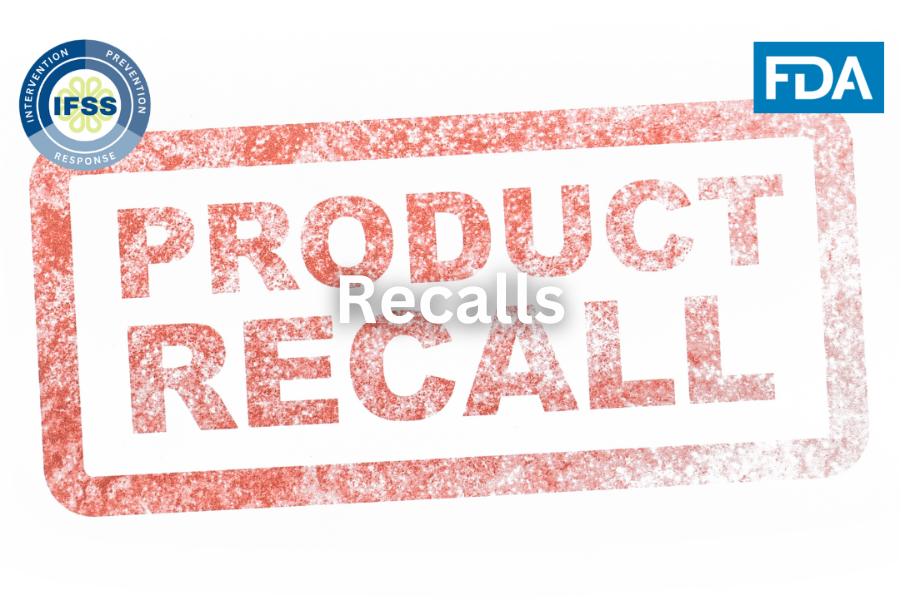IFSS Food Protection Professional NCS
Basic Core
Recalls
Description: Introductory knowledge, skills, and abilities related to the process of removing a product from commerce.
Topic Areas:
-
Description: Basic knowledge of recalls related to regulatory programs.
Terminal Competency:
Describe the importance of recalls.
Enabling Competencies:
1. Define key terminology.
2. Give examples of what could initiate a recall.
3. Explain the differences between recall classifications.
4. Describe the importance of interagency and industry collaboration.
5. Explain the need for communication with stakeholders.
6. Explain agency’s plan for removing product from the distributions system.
7. Explain firm’s plan for removing product from the distribution system.
8. Explain the purpose of a market withdrawal.
9. Trace a product through the supply chain.
To see a set of behavioral anchors, which provide further detail about the enabling competencies and can be used for assessment against the enabling competencies, contact IFPTI.
-
Description: Process to evaluate information for potential health impact of the product if it remains on the market.
Terminal Competency:
Discuss the importance of risk assessment in product safety assurance.
Enabling Competencies:
1. Explain the importance of risk assessment to determine if a recall is needed.
2. Give examples of triggers that could initiate a recall.
3. Explain how the potential severity of the hazard affects risk.
4. Explain how probability of exposure affects risk.
5. Describe how recall classes I, II, III would affect a recall decision.
To see a set of behavioral anchors, which provide further detail about the enabling competencies and can be used for assessment against the enabling competencies, contact IFPTI.
-
Description: Records needed when conducting a recall.
Terminal Competency:
Explain the importance of documents needed when conducting a recall.
Enabling Competencies:
1. Identify documents used to track product movement.
2. Give examples of documents that should be reviewed.
3. Identify the documents that need to be collected.
4. Review documents used to determine the scope of the recall.
To see a set of behavioral anchors, which provide further detail about the enabling competencies and can be used for assessment against the enabling competencies, contact IFPTI.
-
Description: Information sharing and messaging strategies between agencies and stakeholders.
Terminal Competency:
Discuss the role of communication during a recall.
Enabling Competencies:
1. Describe the importance of interagency and industry communication.
2. Explain how communication is coordinated during a recall.
3. Identify requirements related to information sharing.
4. Describe the roles of regulatory agencies in issuing public communications.
5. Explain the importance of sharing lessons learned from recalls.
6. Describe media types used to inform stakeholders of a recall.
7. Explain the criteria for issuing a public health message during a recall.
8. Explain how sensitive communication should be shared with affected stakeholders.
9. Explain when sensitive communication would be shared with affected stakeholders.
10. Describe the agency internal communication process during a recall.
To see a set of behavioral anchors, which provide further detail about the enabling competencies and can be used for assessment against the enabling competencies, contact IFPTI.
-
Description: The process of removing unsafe products from all points of production, distribution, manufacturing, processing, storage, retail, and consumer ownership.
Terminal Competency:
Explain how the recall process is used to remove unsafe products.
Enabling Competencies:
1. Describe how the decision is made to initiate a recall.
2. Describe the process of implementing a recall.
3. Discuss the importance of notifying the public.
4. Describe the process of recall validation.
5. Describe the process of determining if a recall should be initiated.
6. Describe the process of how a recall would be conducted.
7. Explain the process of how relevant stakeholders are notified of a recall.
8. Describe how to verify that a recall has been properly conducted by a firm.
To see a set of behavioral anchors, which provide further detail about the enabling competencies and can be used for assessment against the enabling competencies, contact IFPTI.
-
Description: Ensuring that unsafe products do not reenter the marketplace.
Terminal Competency:
Explain the role of product disposition during a recall.
Enabling Competencies:
1. Explain the importance of product disposition.
2. Give examples of reconditioning products.
3. Explain when a product needs to be destroyed.
4. Describe coordination that may be needed between agencies for product disposition.
5. Describe the verification needed to ensure proper product disposition.
To see a set of behavioral anchors, which provide further detail about the enabling competencies and can be used for assessment against the enabling competencies, contact IFPTI.
Learning Resources:
Assessments:
Coming soon

